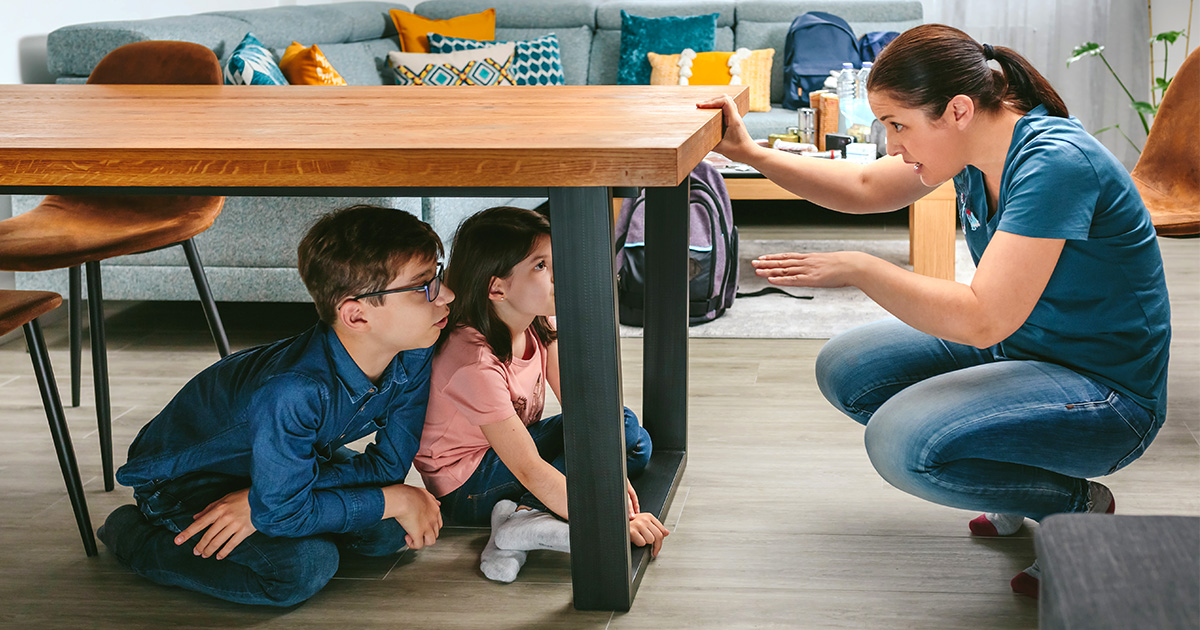- 877.684.1613
- Schedule a Tour

As much as we’d like to shield our loved ones from harm, natural disasters and emergencies do happen. It is important to be proactive and prepare for different scenarios ahead of time, so you and your family members know what to do, just in case. Our teachers and administrators do the same thing to ensure everyone in our schools is kept safe at all times.
Have you talked about a family preparedness plan?
Has your child learned how to exit the house if a fire occurs?
Do you have a designated family meeting spot if an emergency happens?
Start Now
September is National Preparedness Month. There are several things you can do without a threat looming that will put you a few steps ahead if disaster strikes. Review these evergreen tips, make a plan, and be prepared. Your family, your home, and your livelihood are all worth protecting!
When an emergency happens, it can be scary for everyone involved, especially children. Talking about safety measures and procedures is vital to minimizing the effects. Discuss different emergency situations and how responding to them might look different at home vs. at school.
Make sure little ones know their safety is always a top priority.
In Our Schools
Emergency drills are practiced monthly and under various circumstances such as time of day, days of the week, etc. This includes fire drills, evacuations, and severe weather. Our goal is to make sure both staff and children are always aware and comfortable with the procedures we have in place to navigate each type of situation.
Communication is Key
- Staff, parents, and visitors will always know when we are conducting a drill.
- An “Emergency Drill” sign will be placed on the front of the building when one is in progress.
- Each step of the drill is discussed with children, so they know what to expect, how we’ll keep them safe, and why it’s important to practice safe actions.
- Teachers also conduct extra Face-to-Name checks before and after drills to individually count each child. This is a standard, daily safety measure that is used several times throughout a normal school day to ensure all children are present and accounted for.
Comforting Children
- Empathy goes a long way when talking about common concerns. Ex: “Can I grab my toys?” Not right now, toys feel important to us, but your safety is the most important thing right now. We need to line up quickly and hopefully you’ll see them again soon.
- During drills, the buddy system will be used to pair children up with a familiar face.
- We focus on acknowledging their senses. Ex: “You might see flashing lights or hear a loud alarm and it may feel unsettling, but practicing when it’s safe is the best way to feel confident in a real emergency.”
- Teachers use visual prompts and other tools to provide additional support and encouragement to younger students and children with special needs.
In Your Home
Create emergency plans together to build resilience, confidence, and awareness. Involve the children when drawing a simple map to show escape routes, meet-up spots, etc. Make sure they know what to do and where to go should you ever face an emergency.
Prepare for a fire:
Point out the smoke detectors in your home. Test them once a month. This also allows children to learn what it sounds like and to take it seriously during any other time. If you live in a two-story home, make sure you have an escape ladder stored near windows. Practice setting it up too. Remember these tips:
- If the smoke is heavy, crawl close to the floor to avoid breathing the toxic air
- If your clothes catch on fire, practice the “Stop, Drop, & Roll” method
- If you need to call 9-1-1, know how to share your name and address
Prepare for a tornado:
- WATCH: Be aware and ready to take shelter. Tune in to your local TV station to listen to live forecasting or turn on a weather radio for the most updated information.
- WARNING: A tornado (or telltale cloud circulation) has been sighted by trained experts in the area. Take shelter immediately until the threat passes or until the tornado warning expires.
You’ll want to be on the lowest level and away from windows or outside walls. Build an emergency kit to leave in the dedicated safe zone. If the storm gets intense, protect your head and neck with your arms, a pillow, or even a mattress. Talk through the differences between a tornado watch and warning:
Prepare for a flood:
If you live in a flood-prone location, stock your home with rope, a ladder, and sandbag supplies. Prepare an emergency bag with food, medication, a first aid kit, flashlights, etc. Keep it in a designated spot. If you can leave the area before flooding starts, seek higher ground, and follow evacuation orders.
- Avoid crossing streams if the water is above your knees
- Never drive over a flooded road, you don’t know how deep it gets
- Stay away from downed power lines or other hazards
Learn more about preparedness planning by visiting ready.gov. You’ll find games for kids, advice for adults, helpful checklists, and general tips for facing any type of emergency.
